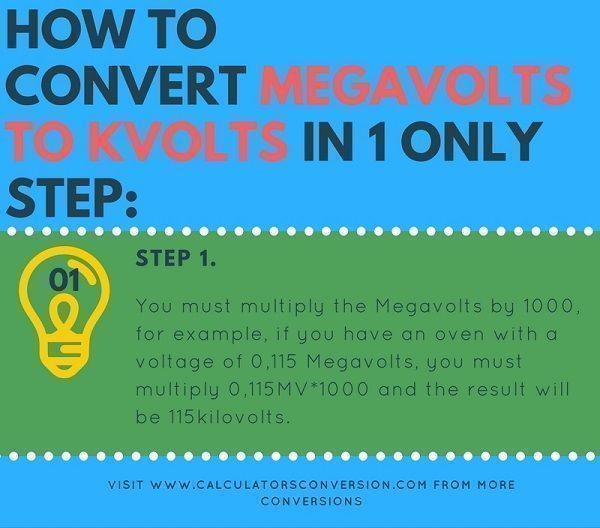With this calculation tool you can convert from Megavolts to kilovolt automatically, easily, quickly and free.
We also explain how to convert from kvolt to megavolt in 1 single step, with the help of the formula that is used for the calculation and with the table that has the main conversions from megavolt to kv.
Formula from conversion, calculate and transform from megavolts to kilovolts, single-phase, two-phase and three-phase:
kVolts=1000 volts.
MegaVolts= 1000 kVolts
How to convert from megavolts to kVolts to in only 1 steps:
Step 1:
You must multiply the Megavolts by 1000, for example, if you have an oven with a voltage of 0,115 Megavolts, you must multiply 0,115MV*1000 and the result will be 115kilovolts.
Table megavolts to kv, conversion, equivalence, transformation:
| Megavolts | kVolts |
| How many is 0,00022 Megavolts | 0,22 kvolts |
| How many is 0,00048 Megavolts | 0,48 kvolts |
| How many is 0,0006 Megavolts | 0,6 kvolts |
| How many is 0,008 Megavolts | 8 kvolts |
| How many is 0,009 Megavolts | 9 kvolts |
| How many is 0,01 Megavolts | 10 kvolts |
| How many is 0,011 Megavolts | 11 kvolts |
| How many is 0,00416 Megavolts | 4,16 kvolts |
| How many is 0,0114 Megavolts | 11,4 kvolts |
| How many is 0,012 Megavolts | 12 kvolts |
| How many is 0,013 Megavolts | 13 kvolts |
| How many is 0,0132 Megavolts | 13,2 kvolts |
| How many is 0,0138 Megavolts | 13,8 kvolts |
| How many is 0,014 Megavolts | 14 kvolts |
| How many is 0,015 Megavolts | 15 kvolts |
| How many is 0,017 Megavolts | 17 kvolts |
| How many is 0,018 Megavolts | 18 kvolts |
| How many is 0,024 Megavolts | 24 kvolts |
| How many is 0,0345 Megavolts | 34,5 kvolts |
| How many is0,0564 Megavolts | 56,4 kvolts |
| How many is 0,06 Megavolts | 60 kvolts |
| How many is 0,115 Megavolts | 115 kvolts |
| How many is 0,23 Megavolts | 230 kvolts |
| How many is 0,5 Megavolts | 500 kvolts |
Definitions kvoltios and Megavolts:
V (Volts) = The volt (symbolized by the letter V) is the international standard unit (SI) of electric potential or electromotive force.
A potential of one volt appears through a resistance of one ohm when a current of one ampere flows through that resistance.
The voltage can be expressed as an average value in a given time interval, as an instantaneous value at a specific moment in time, or as an effective or quadratic mean value (rms). The average and instantaneous voltages receive a negative (-) or positive (+) polarity with respect to a zero or terrestrial reference potential. The rms voltage is a dimensionless quantity, always represented by a non-negative real number.
For a stable source of electric direct current (DC) potential, such as that of an alkaline or carbon-zinc electrochemical cell, the average and instantaneous voltages are both approximately +1.5 V if the negative terminal is considered common ground; the rms voltage is 1.5 V. For the standard service alternating current (AC), the average voltage is zero (the polarity is constantly reversed); the instantaneous voltage ranges from approximately -165 V to +165 V; The effective voltage is nominally 117 V.
Voltages are sometimes expressed in units that represent power multiples of 10 or fractions of a volt.
Megavolts = One megavolt (MV symbolized) is equal to one kvolts divided by 1000 (1 MV = 1kV / 1000).
Ratings calculator from Megavolt to kilovolt to: [kkstarratings]

